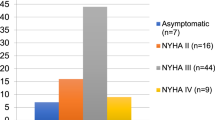Abstract
Aortic valve replacement has been recommended in patients who have severe symptoms, in patients with extreme left ventricle (LV) dilatation (end diastolic dimension >4 SD above normal) or LV ejection fraction <50%. However, the occurrence of advanced symptoms or severe LV dilatation raises concern about irreversible LV dysfunction. This study sought to determine the influence of preoperative symptoms, LV size and function on mortality, and postoperative LV performance in children and adolescence after valve replacement for aortic regurgitation (AR). A total of 49 patients 18 years old or younger (mean, 13.9 ± 3) who underwent valve replacement for chronic AR between 1991 and 2001 were followed up for 1–10 years (mean, 3.3 ± 2.1). Baseline and postoperative characteristics were compared between 13 patients (group 1) with extreme LV dilatation and 34 patients (group 2) with a lesser degree of LV enlargement. Preoperative low ejection fraction (p < 0.008), extreme LV dilatation (p < 0.05), and LV end systolic dimension >4 SD above normal (p < 0.05) were predictors of persistent LV dysfunction. Extreme LV dilatation (p < 0.0003), LV end systolic dimension (p < 0.0007), and reduced LV ejection fraction (p < 0.01) predicted persistent LV dilatation. In the setting of chronic AR, preoperative symptoms, LV systolic function, and LV internal dimensions are the main predictors for persistent LV dysfunction and dilatation. Surgical correction should be performed before LV systolic dysfunction and/or extreme LV enlargement occurs.
Similar content being viewed by others
References
RO Bonow (2000) Aortic regurgitation JS Alpert JE Dalen SH Rahimtoola (Eds) Valvular Heart Disease EditionNumber3rd edn Lippincott William & Wilkins Baltimore 245–268
RO Bonow B Carabello AC Deleon et al. (1998) ArticleTitleACC/AHA guidelines for the management of patients with valvular heart disease J Am Coll Cardiol 32 1486–1588 Occurrence Handle10.1016/S0735-1097(98)00454-9
RO Bonow E Lakatos BJ Maron et al. (1991) ArticleTitleSerial long-term assessment of the natural history of asymptomatic patients with chronic aortic regurgitation and normal left ventricular systolic function Circulation 84 1625–1635 Occurrence Handle1914102 Occurrence Handle1:STN:280:By2D3cngs1Y%3D
JS Borer C Hochreiter E Herrold et al. (1998) ArticleTitlePrediction of indication for valve replacement among asymptomatic or minimally symptomatic patients with chronic aortic regurgitation and normal left ventricular performance Circulation 97 525–534 Occurrence Handle9494022 Occurrence Handle1:STN:280:DyaK1c7ltlSnsw%3D%3D
SD Colan JW Newburger (2000) Acquired heart disease in children E Braunwald DP Zipes P Libby (Eds) Heart Disease EditionNumber6th edn Saunders Philadelphia 1622–1643
WL Henry JM Gardin JH Ware (1980) ArticleTitleEchocardiographic measurements in normal subjects from infancy to old age Circulation 62 1054–1060 Occurrence Handle7418156 Occurrence Handle1:STN:280:Bi6D383ptFU%3D
E Klodas M Enriquez-Sarano A Tajic CJ Mullany KR Baily (1996) ArticleTitleAortic regurgitation complicated by extreme left ventricular dilation: long term outcome after surgical correction J Am Coll Cardiol 27 670–677 Occurrence Handle8606280 Occurrence Handle1:STN:280:BymB3cvot1Q%3D
E Klodas M Enriquez-Sarano AJ Tajik CJ Mullany KR Bailey (1997) ArticleTitleOptimizing timing of surgical correction in patients with severe aortic regurgitation: role of symptoms J Am Coll Cardiol 30 746–752 Occurrence Handle9283535 Occurrence Handle10.1016/S0735-1097(97)00205-2 Occurrence Handle1:STN:280:ByiH38bhvVE%3D
E Klodas M Enriquez-Sarano J Tajik JC Mullany (1996) ArticleTitleSurgery for aortic regurgitation in women Circulation 94 2472–2478 Occurrence Handle8921790 Occurrence Handle1:STN:280:ByiD1c%2FksVE%3D
PL Michel B Iung SA Jaoude et al. (1995) ArticleTitleThe effect of left ventricular systolic function on long term survival in mitral and aortic regurgitation J Heart Valve Dis 4 IssueIDsuppl IIS 160–169
SH Rahimtoola (2001) Aortic valve disease V Fuster RW Alexander RA O'Rourke (Eds) Hurst's the Heart EditionNumber(10th edn) McGraw-Hill New York 1667–1696
AR Snider GA Serwer SB Ritter (1990) Echocardiography in Pediatric Heart Disease Mosby St. Louis 133–230
J Turina J Milincic et al. (1998) ArticleTitleValve replacement in chronic aortic regurgitation. True predictors of survival after extended follow-up Circulation 98 II100–II107 Occurrence Handle9852889 Occurrence Handle1:STN:280:DyaK1M%2FmvF2qsw%3D%3D
Author information
Authors and Affiliations
Corresponding author
Rights and permissions
About this article
Cite this article
Tafreshi, R.I., Shahmohammadi, A. & Davari, P.N. Predictors of Left Ventricular Performance After Valve Replacement in Children and Adolescents with Chronic Aortic Regurgitation. Pediatr Cardiol 26, 331–337 (2005). https://doi.org/10.1007/s00246-005-8645-3
Published:
Issue Date:
DOI: https://doi.org/10.1007/s00246-005-8645-3




